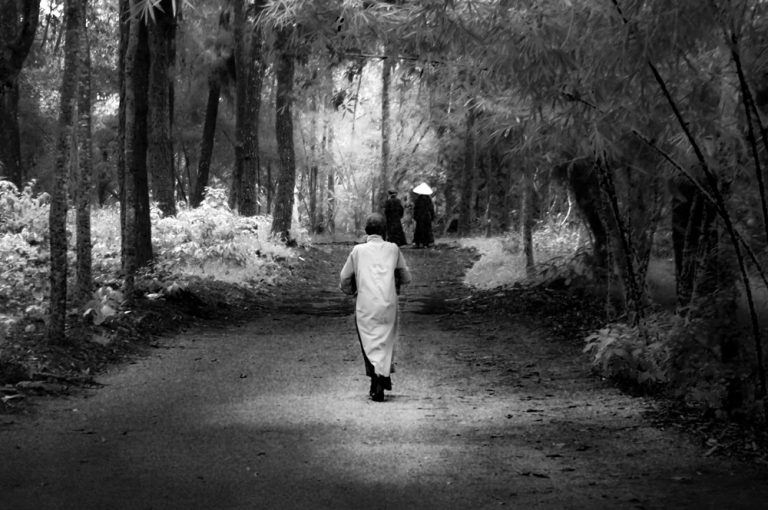In spite of being a daily walker, I have always regarded walking meditation as a sort of punctuation to, or respite from, the work of sitting; nothing on the order of the sober mind training and investigation to be undertaken on the home base of the cushion. This willful delusion could be a hangover from my earliest forays into zazen, where kinhin really was a respite—but also, it seemed to me, a mad, macho dash around the zendo for which I was ill-suited, even as a teenager. Nor was I ever tolerant of the extreme slow motion of Burmese-style vipassana walking. On the contrary, it sent my kleshas into a tailspin, and just made me want to hurry up and sit down.
This isn’t to say that walking to grocery store or the recycling bin doesn’t give me infinite chances to be mindful of the breath and the contact of my soles on the pavement. And there have been those revelatory times on retreat when the walking path became the best place to be. But through these many years, only sporadically did I experience my walking body as the locus of refreshment and concentration that I thought was normally and primarily accessible with glutes planted on the floor. It hasn’t been part of a daily practice, where I set my mind and heart to it, bowed and gave it the respect it’s due. I’ve known I was missing out, or rather, that I wasn’t letting myself in.
Related: Mindfulness on the Move
As with most things that seem hard to undertake, or beyond my ken, it’s usually desperation and the demands of age that force me to really try. Last year, a collusion of physical and emotional shifts shoved me off the cushion and into a series of other postures where I undertook to meditate. In an attempt to jumpstart a better walking practice, I looked for guidance, and came upon a set of instructions for walking meditation online, attributed to Ajahn Mun, the founder of the Thai Forest tradition. The translation is attributed to Thanissaro Bhikkhu, who is quite sure he never did translate them, and a search of Ajahn Mun’s biography and the companion volume, Patipada, both written by the Thai master Ajahn Mahaboowa, turn up no such text.
Regardless of who uttered these lines, their simplicity and forthrightness were what I needed, and re-oriented me to how very available walking meditation is, and what an act of reverence to the dhamma. Another hangover, one many of us nurse through a lifetime, is the din of interior voices telling us we’re not capable of something, that it really isn’t within our grasp. I felt that way for a long time about my own breath, and it took me years to comprehend that I wasn’t doing it wrong, as some of those voices insisted. That playing with and manipulating and sending my breath into all kinds of real and imagined places was my prerogative. And that’s how I learned to meditate. These little instructions, which are nothing new, re-inspired me to collapse the Cartesian distance I’d erected between my pacing body and my fussy mind, and to find another way of accessing what Ajahn Lee called a safe home for the mind. They’re like a plainspoken voice that says, “Do it, out of compassion for yourself.”
Walking Meditation Instructions
The key technique for walking meditation is to be mindful of walking and aware of the touching of the feet to the ground. Before starting walking meditation, the practitioner should prepare a walking path. The walking path should not be shorter than seventeen steps long. The walking path must be clean and smooth. The direction of the walking path, when part of practice, is from the east to the west. Other directions are acceptable if a suitable direction cannot be found, except avoid the direction from the north to the south and from the south to the north.
Before starting walking meditation, the practitioner stands at one end and puts the right hand over the left in front of the body. Having thus composed the body, they should then stand still and bring awareness and attention to the body. Then raise one’s hands together (a gesture of respect) and with the eyes shut reflect for a few minutes on the qualities of the Buddha, the dhamma and the sangha. Then bring the hands down and decide on how long you are going to walk. Focus the eyes down on the ground/floor about six feet in front of you or at a suitable distance for each individual. Don’t look around.
While walking, practitioners mindfully note this arising and passing away of feelings as the soles of the feet lift off or touch onto the ground. Keep the full attention on sensations that arise through walking. Walking quick or slow depends on each practitioner. If the mind wanders a lot, walking slowly is suitable. Then bring the mind back to the sensations at the feet and continue walking. While walking the mind may become calm and tranquil. Stop and stand to allow the mind to experience this calmness and tranquility.
Another way to do walking meditation is to use a mantra like bhuddo [awake]. This technique of practice is like the sitting meditation as mentioned earlier. The practitioner mentally repeats buddho with the breath while walking. Be mindful on the breaths as you repeat the mantra, buddho, all the time. This technique will help calm the mind. However, it is not suitable for beginners because the breath is a subtle meditation subject. Walking meditation combined with the breath with the word buddho is fit for one who has attained a certain degree of stability and calmness beforehand.
Related: Tricycle’s Meditation App Roundup
[This story was first published in 2015]
Thank you for subscribing to Tricycle! As a nonprofit, we depend on readers like you to keep Buddhist teachings and practices widely available.
